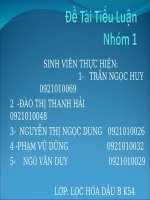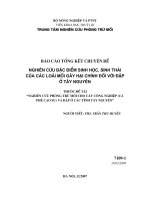Slide cao su hóa học và công nghiệp types of rubber
Bạn đang xem bản rút gọn của tài liệu. Xem và tải ngay bản đầy đủ của tài liệu tại đây (1.31 MB, 34 trang )
cu
u
du
o
ng
th
an
co
ng
.c
om
Types of Rubber
and Their Essential
Properties
CuuDuongThanCong.com
/>
Characteristics
.c
om
Upper temperature aging limits - heat
aging resistance
ng
Chemical resistance and concentration
Chemical resistance and temperature
ng
du
o
u
Mechanical properties and temperature:
Butyl rubber, a fairly non-resilient material at
room temperature can have a significant higher
resilience at 80 "C.
cu
th
an
co
CuuDuongThanCong.com
/>
ng
.c
om
Grades within a type of rubber
u
du
o
ng
th
an
co
All synthetic (and natural) raw
gum elastomers have subdivisions
within their own family.
cu
CuuDuongThanCong.com
/>
.c
om
Natural rubber NR
ng
Production of natural Rubber
co
NR is tapped from rubber trees
(Hevea brasiliensis) as latex.
Latex is a colloidal dispersion of solid
particles of polymer polyisoprene in
water and dry rubber content in the
emulsion is about 30%
cu
u
du
o
ng
th
an
CuuDuongThanCong.com
/>
.c
om
ng
co
an
th
ng
du
o
u
cu
CuuDuongThanCong.com
/>
cu
u
du
o
ng
th
an
co
ng
.c
om
Chemical structure of
natural rubber
CuuDuongThanCong.com
/>
.c
om
Natural rubber NR
in many grades related
to its ‘dirt’ content and precise
method of production.
Popular grades are ribbed smoked
sheet (RSS) and technically
specified rubber such as SVR
(Standard Vietnamese Rubber)
cu
u
du
o
ng
th
an
co
ng
Available
CuuDuongThanCong.com
/>
Addition of carbon black to a compound
gives resistance to UV, antiozonants
Antiozonants and waxes support ozone
resistance.
th
an
co
ng
.c
om
cu
u
du
o
ng
Ozone attack is of most concern for thin
products and those that are subjected
to stretching during service.
CuuDuongThanCong.com
/>
insulation is very good and,
like all elastomers, depends on
compounding.
Resistance to petroleum oils is poor
Resistance to alcohols (such as
ethanol and methanol) and ketones
(such as methyl ethyl ketone (MEK)
and acetone) is much better
cu
u
du
o
ng
th
an
co
ng
.c
om
Electrical
CuuDuongThanCong.com
/>
20,
50: the lower the number, the
cu
u
du
o
ng
th
an
co
ng
.c
om
cleaner the grade, and therefore
the more expensive
Specialized grade known as SMR
CV with consistent viscosity
control of NR (constant viscosity)
is available. This grade has 0.15%
of a hydroxylamine salt added to
prevent a ‘cross-linking’.
CuuDuongThanCong.com
/>
cu
u
du
o
ng
th
an
co
ng
.c
om
Styrene butadiene rubber SBR
CuuDuongThanCong.com
/>
.c
om
Styrene butadiene rubber SBR
From petroleum oil
There are many subgroups of the raw
gum elastomer
In comparison with natural and CR,
gum vulcanizates made from SBR
have poor mechanical properties
therefore must have reinforcing fillers
such as carbon black
cu
u
du
o
ng
th
an
co
ng
CuuDuongThanCong.com
/>
.c
om
The properties of SBR are broadly
similar to NR, for chemical, solvent,
and weather resistance.
The upper temperature heat aging
resistance limit is a little higher.
cu
u
du
o
ng
th
an
co
ng
CuuDuongThanCong.com
/>
cu
u
du
o
ng
th
an
co
ng
.c
om
Polychloroprene CR
CuuDuongThanCong.com
/>
.c
om
Polychloroprene CR
Known as Neoprene
More specialized than the two
previous elastomers (oil and weather
resistance)
Ability to retard flame
Resistance to dilute acids and bases
is better than that of NR or SBR
cu
u
du
o
ng
th
an
co
ng
CuuDuongThanCong.com
/>
cu
u
du
o
ng
th
an
co
ng
.c
om
Nitrile Rubber NBR
CuuDuongThanCong.com
/>
.c
om
Nitrile Rubber NBR
Known as acrylonitrile butadiene rubber,
Buna-N and simply nitrile
Oil resistant properties
The higher the amount of ACN in the
elastomer, the better the oil resistance
The weather resistance of NBR is poor,
similar to NR and SBR
cu
u
du
o
ng
th
an
co
ng
CuuDuongThanCong.com
/>
Better heat aging resistance than CR
and is in the region of 1070C for
continuous use.
an
Needs reinforcing fillers.
ng
th
co
ng
.c
om
u
du
o
Poor resistance to polar liquids such
as ketones, esters, chlorinated
solvents, and many aromatic solvents
such as benzene and toluene
cu
CuuDuongThanCong.com
/>
.c
om
Ethylene propylene rubber EPM
and EPDM
is a copolymer consisting of
ethylene and propylene units as
part of the main polymer chain.
It can be cross-linked with
peroxides or radiation but not
sulfur
cu
u
du
o
ng
th
an
co
ng
EPM
CuuDuongThanCong.com
/>
co
ng
.c
om
Ethylene propylene diene terpolymerEPDM
Unaffected by weather with very good
resistance to ozone
Upper 'continuous‘ heat aging
temperature limits in air, anywhere
from 1260C to around 1500C
cu
u
du
o
ng
th
an
CuuDuongThanCong.com
/>
Low temperature flexibility is very good
and even better when compare with NR.
Very poor oil resistance.
Resistance to a number of concentrated
mineral acids and bases is significantly
better than that of NR or SBR
Excellent electrical resistance of EPDM
cu
u
du
o
ng
th
an
co
ng
.c
om
CuuDuongThanCong.com
/>
cu
u
du
o
ng
th
an
co
ng
.c
om
Butyl rubber IIR
CuuDuongThanCong.com
/>
.c
om
Butyl rubber IIR and halobutyl
rubber CllR and BllR
Some properties similar to those of EPDM.
Good mineral acid and base resistance.
Good weather resistance (similar to that
of EPDM).
Excellent resistance to gase permeability
Poor resistance to petroleum oils
cu
u
du
o
ng
th
an
co
ng
CuuDuongThanCong.com
/>
Upper continuous heat aging temperature
limit is around 1210 C degree.
Applications for vibration and shock
prevention, roof and tank linings, curing
bladders and inner tubes for tires.
Halobutyls can be blended with
unsaturated elastomers such as NR,
whereas for IIR it is not recommended
cu
u
du
o
ng
th
an
co
ng
.c
om
CuuDuongThanCong.com
/>
.c
om
Silicone rubber
cu
u
du
o
ng
th
an
co
ng
MQ = Methyl-Polysiloxane
VMQ = Vinyl-Methyl-Polysiloxane
PMQ = Phenyl-Methyl-Polysiloxane
PVMQ = Phenyl-Vinyl-MethylPolisiloxane
CuuDuongThanCong.com
/>









